The following was originally a series of posts published on Facebook by Rabbi Dr. Leshem. It is reprinted here with the author’s permission.
Rabbi Dr. Leshem also remembers Rabbi Halivni in this Youtube video.
Rav Zvi was a close student and disciple of Rav Halivni z”l from 1975 until Rav Halivni’s passing.
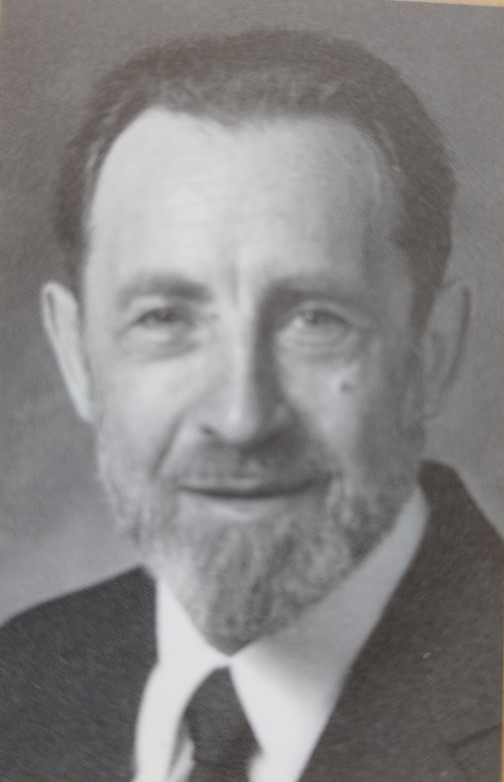
- Baruch Dayan HaEmet. With unbearable pain I share that the Sigheter Ilui, HaRav Prof. David Halivni zt”l has passed. He was the greatest academic Talmud scholar of our generation, but for me, he has been a spiritual father for 47 years. From the moment I met him, I have always clung to him. No funeral details yet.|
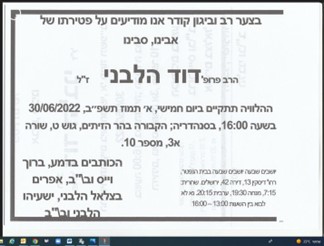
- The truth is that I wasn’t sure how I would get through the funeral of my mentor zt”l. In retrospect, it provided badly needed closure. His three sons, Baruch, Rav Ephraim and Shai, all spoke beautifully (watch funeral here), as well as one of his granddaughters. The burial on Har HaZatim, with a breathtaking view of the Temple Mount, and next to his beloved Rebbetzin, Tzipporah (engraved on her tombstone, “Holocaust survivor, daughter of the Admor R. Baruch of Vishiva [Vishnitz line] HYD and wife of Rav David Halivni, Eshet Chayil Mi Yimtzah”), was comforting. The past few years have been so hard, seeing my beloved Rebbe suffering so much. That is finally over, and as Baruch said, he is probably sitting in Heaven learning with the Stamaim, whom he essentially discovered, and spent the last 50 years learning and explaining their Torah. But it is still very hard for me…very hard. As we know a Torah scholar’s words are his eternal monument, and BH Rebbe David zya left us much Torah to learn.
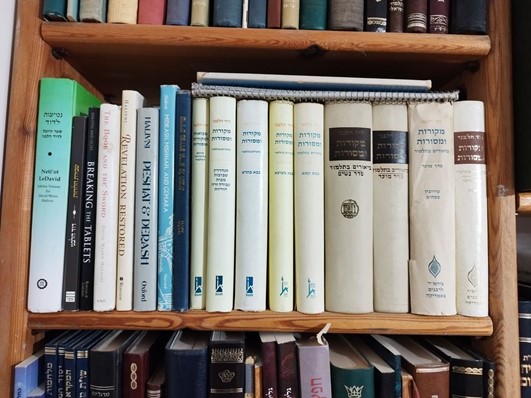
We await the posthumous publication of Mekorot u’Mesorot on Zevachim-Menachot-Chulin, the last tractates that he taught, and that BH I learned with him. Ephraim is editing it. As the Komorner Rebbe shlit”a said to me, “We had better start learning, an enormous hole has been left”. (Pictures from Maayan’s brit, on the 18th of Tammuz 1985 – a delayed fast like this year. Rav Halivni the sandak with the legendary Jerusalem mohel, R. Yossele Weisberg z”l in action. And then leading bentching at the seuda in our apartment in Har Nof that night. Next to him is my father-in-law, Prof. Allen Kropf). Shabbat Shalom.
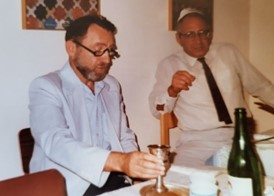
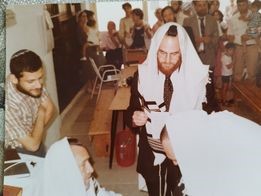
- A less personal post about Rav Halivni zt”l’s magnum opus, his Talmudic commentary “Mekorot U’Mesorot”. The first volume, on Seder Nashim, came out in 1968, followed by the second on Moed (Yoma-Hagiga) in 1975, the year that I met him. He then went back to Shabbat-Pesachim, and afterwards all of Nezikin. A separate volume of all of the introductions was also published, which is of crucial importance as it chronicles the development of this methods and theories in general and particularly as it relates to the lateness of the Stam. He told me that he started with Nashim because that was what he was learning at the time. He initially skipped the first tractates of Moed because he wanted to avoid topics that were more relevant to practical Halacha. He was always concerned lest people take the methods or conclusions of his Pshat commentary (“Torat Emet”) and apply them to practical Halacha (“Torat Haim”). This of course reflects his simultaneous exegetical radicalism and Halachic conservatism. His son Rav Ephraim is currently editing the volume on the beginning of Kedoshim, the last tractates that he taught before becoming ill. What won’t we have? Brachot. This would have been very interesting as there is a lot of Agadita, which interested him less, and I think he saw less reason to apply his method to it. On the other hand, his student Prof. Jeffrey Rubenstein from NYU does just that (which he found somewhat surprising. He very much appreciated Prof. Rubenstein’s English book on this theories regarding the composition of the Bavli). I also once heard a great lecture from Rav Dr. Ori Lifshutz in that direction, which showed how the method can be applied to understand the development of Rabbinic theology as expressed in the Agada. We also won’t have the second half of Kedoshim or Nida. Lastly it is important to realize that the first volume on Nashim was published before his great chidush about the lateness of the Stam, which appears only in the second volume. I often mentioned to him the need for a mahadura batra of Nashim as well. I will end by noting that in the midst of this great unfinished project, the Rav took off a lot of time to write an autobiography and four other English books about Rabbinic theology. In his autobiography he mentioned his disappointment in not succeeding in giving over his methodology to most of his students (yes it helps to have been an ilui and a gaon). So he clearly felt the need to give over his Torah to a wider audience, and he did so beautifully. Nonetheless חבל על דאבדין ולא משתכחין. Finally, he once mentioned to me that whereas almost all of the Wissenschaft scholars had abandoned the Bavli for less “yeshivaish” pursuits (Yerushalmi, Tannaitic Literature, Mesechtot Ketanot etc.), he had remained faithful to “unzera Gemara”.(picture from Maayan’s Bar Mitzva 1998, with my father z”l as well. At the Bar Mitzva he also met my father’s brother, Uncle Sam z”l, who had recently made Aliyah from the Carpathians. It turned out that in the Shoah, they had been in all of the same camps.).
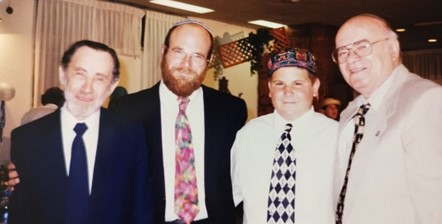
(Comment): Regarding Rav Halivni’s methodology in relation to Agada, I see now that he contributed a chapter, “Aspects of the Formation of the Talmud” to Rubenstein’s 2005 book, “Creation and Composition: The Contribution of the Bavli Redactors (Stammaim) to the Aggada”. He concludes, “At all events, aggadic texts are no more fixed than halakhic texts despite the existence of books of aggada and the absence of books of halakha. Books of halakha did not require additional modes of preservation. Halakha was preserved by its apodictic and legislative form”. המבין יבין, זיל גמור. See also his “The Book and the Sword” pp. 137-138: “The comparative method deals primarily with the non-legal aspect of the Talmud, the aggadah…story-telling, aphorisms, and the like, has greater affinity with the outside world than does halakhah. Jewish law is unique”. By “comparative” he means classic philology, as in the works of HaGaon R. Shaul Lieberman. By contrast, he refers to his own approach as “text-immanent”.
- Very brief impressions from my shiva visit yesterday. I spoke a lot with the youngest son, Shai, who was a “little kid” when I was in New York. One year I went to the Halivni’s seder. Shai was the youngest there (about 10 years old). He sat next to his father, and at the end of each section of the Hagada, after all of the discussions, the Rav would turn to him and explain the pshat of that section and make sure that he understood before he went on. והגדת לבנך – כפשוטו. I also spoke for a while yesterday with Niko, the Rav’s dedicated caregiver from the Philippines for the last four years. He tearfully and repeatedly referred to his charge as “Aba”. I think that speaks for itself. Pictures from Elie and Hadar’s wedding about 15 years ago. Elie and Rav Halivni at the Chosson’s tisch. The Rav reading the Ketuba. He made a point of reading the word שטרי twice, pronouncing it both “shtarei” and “shitrei”, apparently an inside Achronishe joke that only the Daayan, Rav Ariel Holland shlit”a understood. People said that he read a Ketuba as though he was telling a story. In that picture, Julie, Maayan (MC) and myself (Mesader Kidushin).
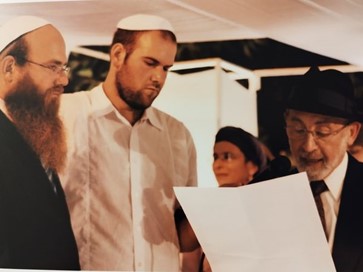
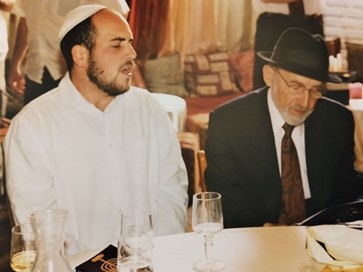
- Old memories…I came to the Joint Program (JTS and Columbia) in the fall of 1975 as a fairly recent Baal Teshuva. I had never heard the name of Prof. David Halivni, or as everyone referred to him then, “Reb Duvid Weiss”. While it’s true that Rebbe Yoilish of Satmar once told his wife that “Weiss had become a Litvak”, in the context of the very Litvish atmosphere of JTS, to me he seemed not only chassidish, but like a Rebbe. Although only about 48 years old, he had a regal bearing, a beard, davened with his Talis over his head, and prayed in a side room until Barachu, when he would enter the shul, like a Rebbe. Later I would learn that had married into the center of the Hager family, the Zaddikim of Vishnitz and Vishiva. And his accent was just like my father’s! I decided that he was the one I wanted to get close to and made it my point to do so (although surprisingly I don’t remember our first conversation, or how I got up the courage to approach him). I soon became a regular in his office, where, when we chatted, he would come out from behind his desk and sit in a big green easy chair which he kept for that purpose. It would only be in my 4th year that I would attend his Advanced Talmud shiur (Eruvin ch.10. He generally taught what he was working on at the time in Mekorot U’Mesorot). He taught the shiur in his office (about 6 students) in the middle of Sunday afternoon. Other than that the building (excluding the library) was deserted. I think he wanted to send the message that learning Torah doesn’t have a day off. In shiur we had to have a copy of Dikdukei Sofrim as well as the Gemara. He made it clear that without establishing the correct text one could not begin to learn. If I recall, we did all the Rashi and Tosafot, and a lot of Ritva and Meiri. We also used a less well-known Rishon – R. Yishmael ben Hachmon. We once asked to learn a sugya with an Achron to get a taste of that style and we did “HaGaon Yaacov”, a student of the Vina Gaon. A part of his mastery of rabbinic literature was knowing which Rishonim and Achronim were especially important for each tractate. Of course he would then give his own chidush about how the sugya had developed. Religiously speaking, he would tell his “chassidim” that we had to reject the Documentary Hypothesis and “feel bad if you miss Mincha”, i.e. fidelity to both traditional faith and praxis. The Seminary Synagogue had a mechitza, but on Shabbos the davening was in the auditorium, which had separate seating without a mechitza. You could tell his chassidim – they stood behind the pillars to daven the Amida, like he did. He never used a siddur on weekdays or Shabbos, only on Yuntef.Pictures: 1: Shoshi and Harel’s wedding 5 years ago, With our Rebbe, Rav Safrin of Komorno shlit”a, my mom, Maayan and myself. 2: Dedication to me (prior family name “Blobstein”) in is 1996 autobiography.
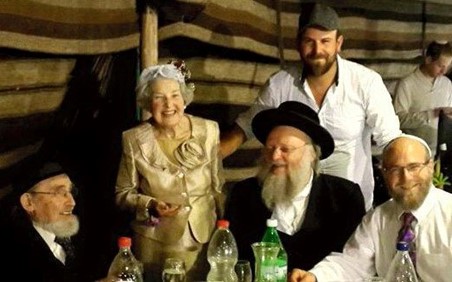
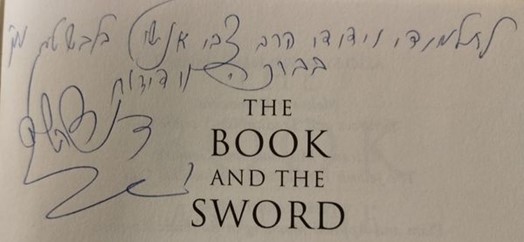
- From the time that I met Julie and introduced her to Rav Halivni, he was very supportive of our shidduch. When we got engaged, on the morning of Yom HaAtzmaut 1978, I first went to inform him. After receiving his bracha I called my parents to share the good news. In general he was concerned about people’s shidduchim. After one very joyous wedding, where apparently he noticed the young people fraternizing, he remarked, “I think some more shidduchim will come out of this wedding”. Recently, whenever a certain friend of mine would visit him, he would always ask, “why aren’t you married yet”, and advise him on shidduchim. When Julie decided to volunteer on Kibbutz in the summer of 1978 he encouraged her to go to Saad and connect with his wife Tzippora’s first cousin, Tzippora (Friedman) Ben Shalom, the sister of the Vishnitzer Rebbe. At that time her husband, Reb Yisrael was finishing his doctorate in Second Temple history at Tel-Aviv. Later they moved to the Bet Yisrael (mixed religious – secular) urban Kibbutz in Gilo, where he became the Pashkaner (Rhuzhin) Rebbe until his passing a few years ago. Julie became a bat bayit by them and when in 1980 we went as a young couple to Saad for Pesach we also visited them. I clearly remember the beautiful hasidic zemirot at Seuda Shlishit…Pictures: Two mazel tov letters that we received for the births of Zion (1983) and Kinneret (1992). In the second letter he refers to me by my second name only, “Anshil”, which he did sometimes in writing, but not when we spoke. In that letter, he mentions sources for each of the blessings of “Torah, chupah and good deeds”, two of them from footnotes to his own Mekorot U’Mesorot. As usual he looks forward to returning to Israel so that we can be משתעשע בדברי תורה, “delight in sharing Torah discussions”. His shiva ended this morning.זכר צדיק לברכה, זכותו יגן עלנו.
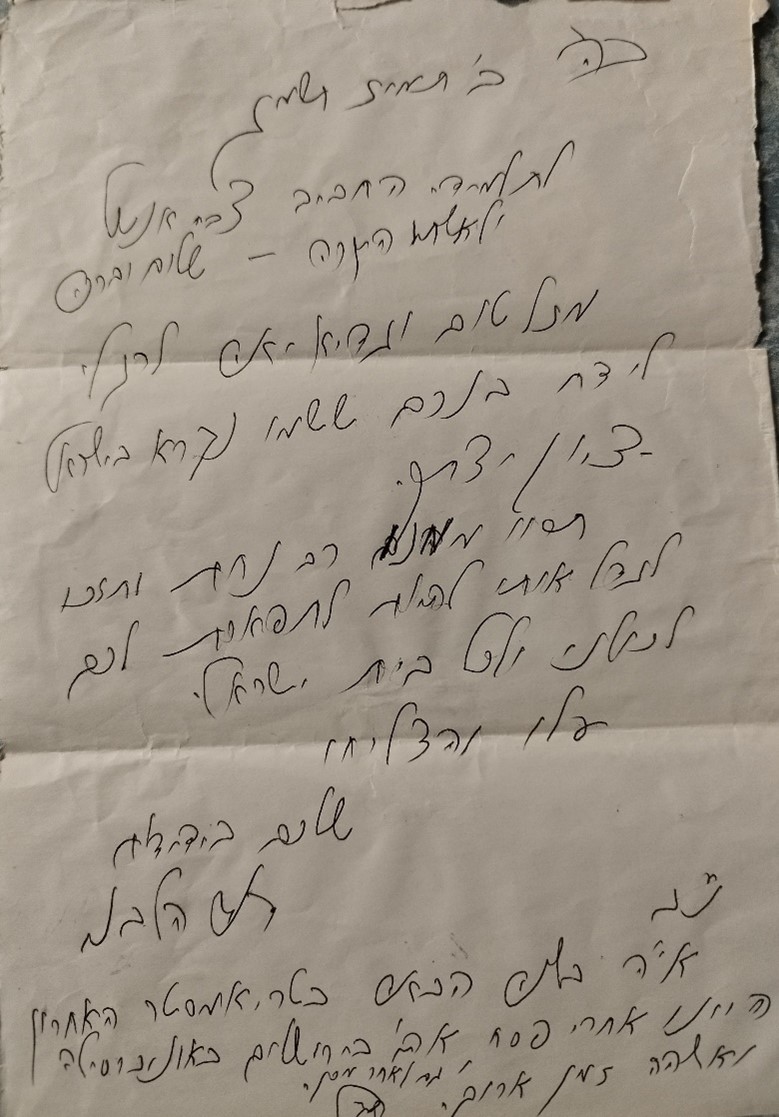
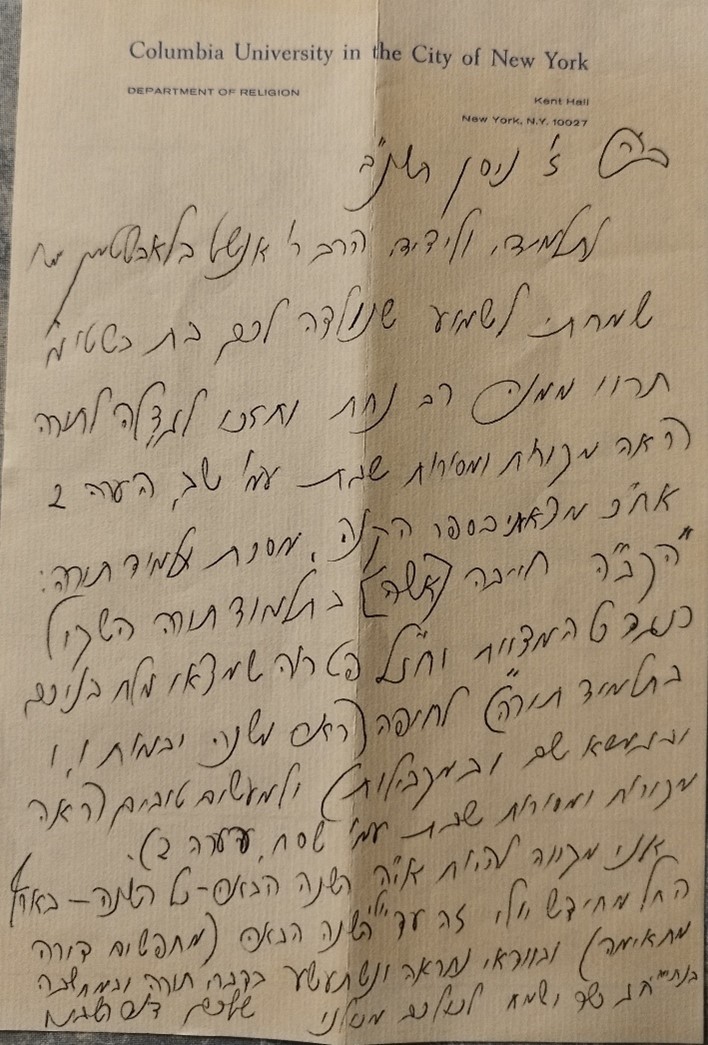
- Two more letters from Rav Halivni.Letter 1: Spring 1992, the Rav informs me that he will be coming to Israel for an entire year and that we will be able to “delight in discussing Torah and Yirah”. An additional mazel tov for the birth of “our son” (he seems to have forgotten that it was a girl!).Letter 2: The first day of Slichot (Fall 1997). This one is the most important in terms of content. He thanks me for wishing him a mazel tov on his son Baruch’s wedding. He then writes, “May we witness the salvation of Yehudah and Yerushalayim, and that the confusion currently prevalent there (Israel) and here (America) will soon disappear”. I really don’t recall what he was referring to, but it still sounds relevant! Lastly, and most importantly, he responds to certain theological questions that I had written him regarding his autobiography and his discussion of the Holocaust. Among his comments, “The theological concept of ‘whatever HaShem does is for the good’, when applied to Klal Yisrael…stems from a lack of courage to deal with the realities of life, and these ideas are ancient (והדברים עתיקים)”.
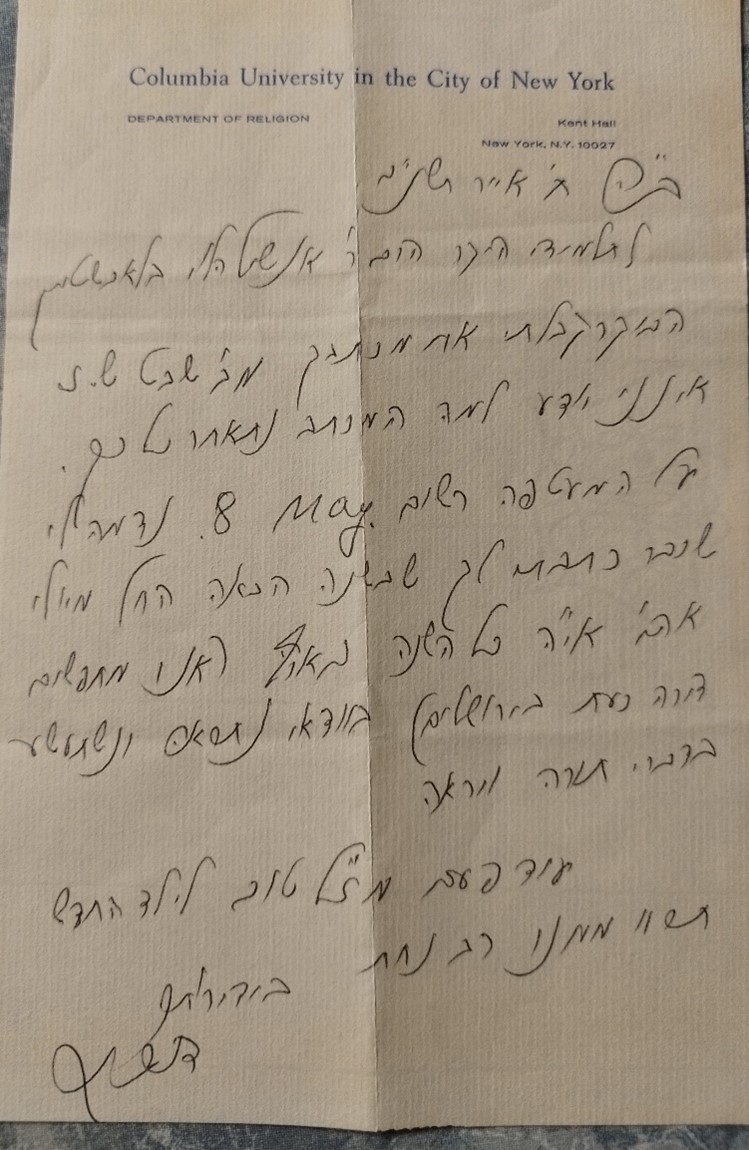
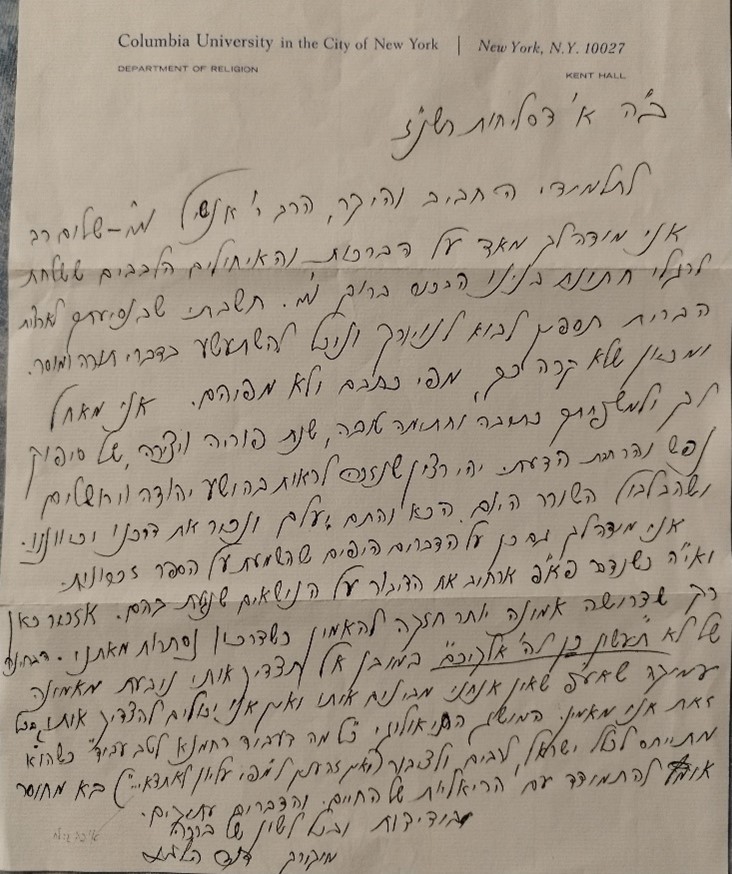
- Shavua tov. I previously mentioned RD Halivni’s interest in shidduchim. A word about his own. As a young teenager he was taken to Vishiva to be tested by the Vishnitzer Rebbe zt”l. Needless to say, he passed with flying colors. There was only one question he couldn’t answer. The Rebbe asked him why the Rambam has Hilchot Teshuva (“The Laws of Repentance”), but Shulchan Aruch doesn’t. He was stumped. In the manner of Chassideshe humor, the Rebbe answered, “The Rambam includes all of the laws, whereas the SA only includes those that are relevant in our era”! At this meeting there was talk about a shidduch with the Rebbe’s granddaughter Tzippora z”l. According to some versions of the story, she was present and expressed an interest. Nothing was settled at the time, and soon both were in Auschwitz. They met after the War at Brooklyn College and got married.On another topic, RDH wrote his MA thesis at NYU comparing the writings of the Protestant theologian Paul Tillich to Jewish thought. I know it is a long shot, but if anyone has a copy please be in touch. His sons don’t and it should really be kept for posterity if it exists somewhere. I would love to read it. [It is not in the NLI or the JTS Library, and as of now I have not located one at NYU either). Lastly, my Nishmat students and colleagues should get a kick out of the way he addressed the envelope (1997) in the picture to me.
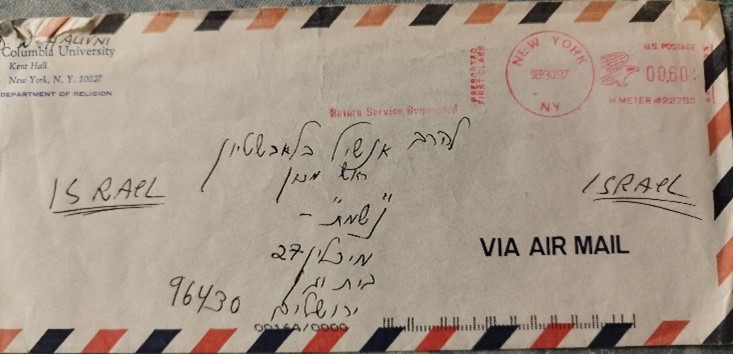 Since somehow this thread has turned into a discussion of Smicha, here is RDH’s second. The first יורה יורה ידין ידין was from the Sigheter Dayan R. Gross HYD when RDH was 15. That was lost in the War. When he was in Chaim Berlin (where I believe, Rav Hutner zt”l learned with him in chevruta for 7 years), he decided to get smicha from a “Litivishe Gadol” as well, so he went to Rav Tomoshav (Mabit) zt”l, who proclaimed that he was destined to become “one of the greatest Geonim of the generation”. I believe he later got a third from Rav Lieberman zt”l. These three ordinations represent his journey from Hungarian style breadth and pilpul to Litvish lumdus and analysis, and finally to critical scholarship. Of course within the last category he also branched out into previously uncharted waters….
Since somehow this thread has turned into a discussion of Smicha, here is RDH’s second. The first יורה יורה ידין ידין was from the Sigheter Dayan R. Gross HYD when RDH was 15. That was lost in the War. When he was in Chaim Berlin (where I believe, Rav Hutner zt”l learned with him in chevruta for 7 years), he decided to get smicha from a “Litivishe Gadol” as well, so he went to Rav Tomoshav (Mabit) zt”l, who proclaimed that he was destined to become “one of the greatest Geonim of the generation”. I believe he later got a third from Rav Lieberman zt”l. These three ordinations represent his journey from Hungarian style breadth and pilpul to Litvish lumdus and analysis, and finally to critical scholarship. Of course within the last category he also branched out into previously uncharted waters….
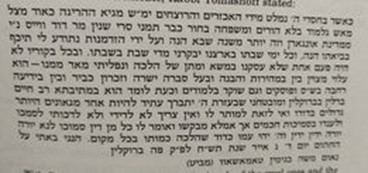
- On Rav David Halivni (RDH) and Gershom Scholem: Scholem was 30 years older than RDH, so it wasn’t an “even” friendship. I suspect that it was initially established via Rav Shaul Lieberman, RDH’s mentor and a very close friend of Scholem. I once asked RDH what Scholem and the Grash Lieberman had in common, as they seemed to have come from such different backgrounds, lived different lifestyles and had different scholarly pursuits. (There is an urban legend that the Grash was once in Scholem’s apartment, with a library of some 30,000 volumes, and quipped, “But there is nothing here to read!”). RDH’s answer – “they were both lovers of Torah”.When RDH left JTS over the issue of women’s ordination, Scholem reacted incredulously, and told him, “but you are the Welhausen of the Talmud!” Apparently Scholem found it difficult to understand how one could simultaneously be both a critical text scholar and a conservative Halachisist. In the Scholem Collection there is one offprint of a RDH article and a photocopy of another. The offprint is of “Contemporary Methods of the Study of the Talmud” (Journal of Jewish Studies 30:2, Autumn 1979), and is annotated with Scholem’s marginalia. It is possible that Scholem had some of Rav Halivni’s books as well. Not everything from Scholem’s home collection came to the Library, but that is for a separate discussion.Since we have mentioned R. Lieberman, I will close with a little-known anecdote that RDH one shared with me. The first time that he visited Israel (early 60s I believe) was to lecture at the World Congress of Jewish Studies. When he entered the lecture Hall he saw Shai Agnon (whom he recognized from pictures) sitting in the front row. He couldn’t figure out what he was doing there. When he returned to New York he mentioned this to R. Lieberman who chuckled and said, “Agnon is always telling me that I probably don’t have any good students in Chutz L’Aretz, so I told him he should go listen to you”. On that note, in the “HaDoar” 1963, special edition in honor of R. Lieberman’s 65th birthday features an “ad” from Agnon. In it he reflects sadly upon R. Lieberman living in Chutz L’Aretz, [although he did also own an apartment in Jerusalem, close to Scholem, were he resided much of the time in his later years], but concludes, “As long as most of Am Yisrael is in exile it is good that this scholar, a true Goan, is in their midst, for surely HaShem sent him as a salvation, to raise up a great remnant”. RDH also has an article in the same edition of “HaDoar”, לפרושה של סוגיה בירושלימי. May the merit of all of them stand for us and all of Am Yisrael.
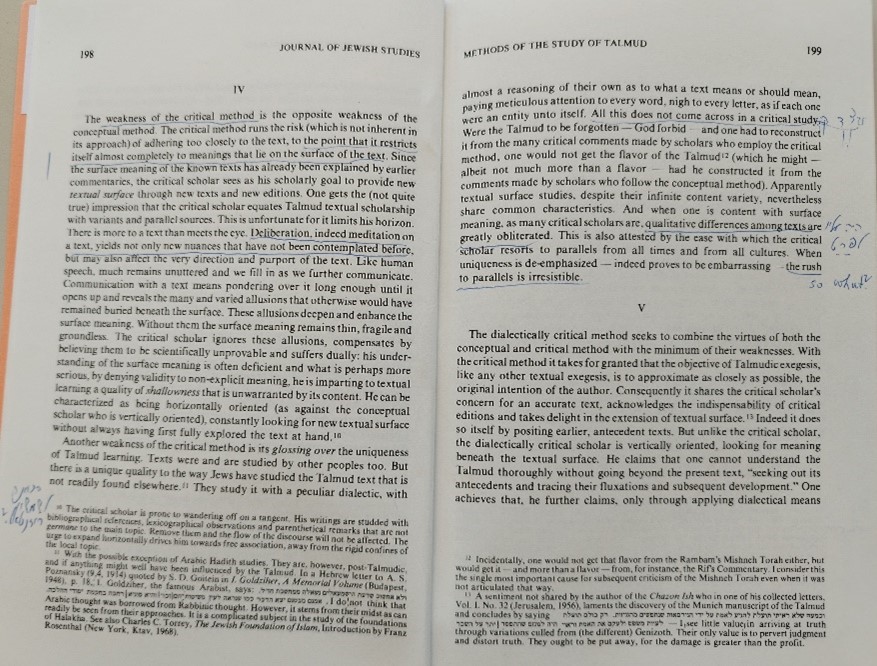
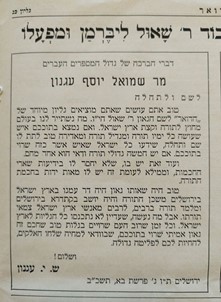
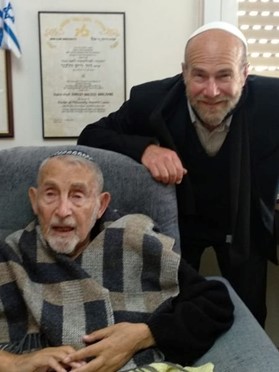 There is an audio of Scholem presenting a paper and R. Halivni responding (1973) here.I speak about our relationship and memories of Rav Halivni zt”l (Hebrew) on Youtube here.
There is an audio of Scholem presenting a paper and R. Halivni responding (1973) here.I speak about our relationship and memories of Rav Halivni zt”l (Hebrew) on Youtube here.
Enjoying UTJ Viewpoints?
UTJ relies on your support to promote an open-minded approach to Torah rooted in classical sources and informed by modern scholarship. Please consider making a generous donation to support our efforts.
Donate Now














 Since somehow this thread has turned into a discussion of Smicha, here is RDH’s second. The first יורה יורה ידין ידין was from the Sigheter Dayan R. Gross HYD when RDH was 15. That was lost in the War. When he was in Chaim Berlin (where I believe, Rav Hutner zt”l learned with him in chevruta for 7 years), he decided to get smicha from a “Litivishe Gadol” as well, so he went to Rav Tomoshav (Mabit) zt”l, who proclaimed that he was destined to become “one of the greatest Geonim of the generation”. I believe he later got a third from Rav Lieberman zt”l. These three ordinations represent his journey from Hungarian style breadth and pilpul to Litvish lumdus and analysis, and finally to critical scholarship. Of course within the last category he also branched out into previously uncharted waters….
Since somehow this thread has turned into a discussion of Smicha, here is RDH’s second. The first יורה יורה ידין ידין was from the Sigheter Dayan R. Gross HYD when RDH was 15. That was lost in the War. When he was in Chaim Berlin (where I believe, Rav Hutner zt”l learned with him in chevruta for 7 years), he decided to get smicha from a “Litivishe Gadol” as well, so he went to Rav Tomoshav (Mabit) zt”l, who proclaimed that he was destined to become “one of the greatest Geonim of the generation”. I believe he later got a third from Rav Lieberman zt”l. These three ordinations represent his journey from Hungarian style breadth and pilpul to Litvish lumdus and analysis, and finally to critical scholarship. Of course within the last category he also branched out into previously uncharted waters….


 There is an audio of Scholem presenting a paper and R. Halivni responding (1973) here.I speak about our relationship and memories of Rav Halivni zt”l (Hebrew) on Youtube here.
There is an audio of Scholem presenting a paper and R. Halivni responding (1973) here.I speak about our relationship and memories of Rav Halivni zt”l (Hebrew) on Youtube here.


















